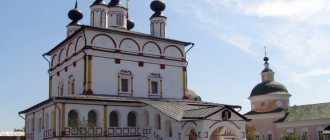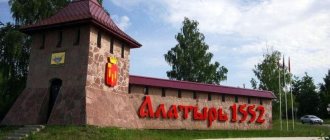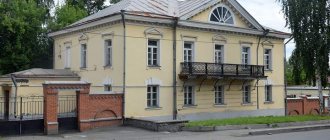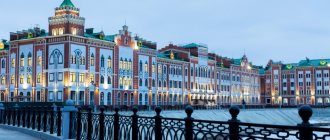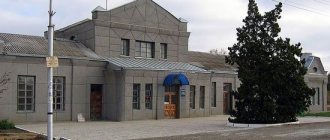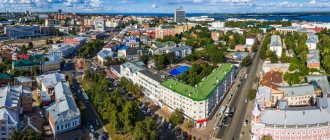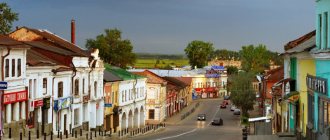Sizran
general information
Syzran is the regional center of the Samara region.
It perfectly combines tradition and modernity. The city captivates with its completely unique appearance, because its historical center has been preserved almost in its original form, many buildings are true masterpieces of wooden architecture. The city is rightfully proud of its outstanding fellow countrymen. These include: writers A. N. Tolstoy and K. A. Fedin, composer A. I. Ostrovsky. Syzran is very interesting for its attractions: museums, temples, ancient merchant estates, and an arboretum.
Story
The founding date of the city is considered to be 1683, when on the site of the Syzran settlement, according to the decree of Tsars Peter Alekseevich and Ivan Alekseevich, the Syzran fortress was founded. There were two goals pursued. The first is to provide protection for the region from attacks by hordes of Nogai and Crimean khans and Volga robbers. The second is to more actively pursue economic development of these rich lands and waters. The pace of construction of the fortress was simply fantastic. Soon powerful oak walls of the fortress grew, which crowned a considerable height of the rampart. Settlers poured into Syzran in a powerful stream. Soon enough, the fortress began to lose its strategic importance and trade and agriculture began to come to the fore. In 1781, Syzran received the status of a county town. Before the revolution, the main activity of the townspeople was the processing of agricultural products. In terms of the amount of flour produced, Syzran ranked 4th in Russia.
In the post-revolutionary period, a great stimulus for the development of industry in Syzran was the discovery of oil and oil shale in its depths. Syzran even began to be called the second Baku. Over time, an oil shale processing plant was built; its products are in demand in many countries around the world, as they are the starting material for the production of many types of medicines.
Transport
Most of the transportation is carried out by municipal, departmental and commercial buses (46 routes), connecting all parts of the city with each other. In addition, there is one trolleybus route in Syzran, and the Syzran trolleybus network is one of the youngest in Russia, it was opened on September 1, 2002. The city also has two railway stations (Syzran-1 and Syzran-Gorod stations), a bus station, a river station and a river cargo port.
OOO "KTV-LUCH" - Official website
—————————————————————————————-
“By the way, the Syzran River or, in our opinion, Syzranka, was indicated on the drawing of the Russian state already in 1626.
But only in 1683 it was decided to build a fortress here.” Alexander Evgrafov, researcher at the Local History Museum of the city.
Sizran ------------------------------
In the collection V.F. Barashkova, E.L. Dubman, Yu.N. Smirnov “Samara toponymy” 1996 about the origin of its name the following is said: “The sources of the river are in the Baryshsky district of the Ulyanovsk region. Its length is a little more than one hundred and sixty kilometers. The name is related to the Tatar common noun “syza”, used in the meaning of “ravine, beam”, and the final part of the hydronym “-ran” goes back to the indicator of the initial case characteristic of some Turkic languages, equivalent to the Russian preposition “from”. Hence “Syzran” literally means “Ravine, flowing from a ravine.”
Initially, the city of Syzran was founded as a fortress. It was located near the mouth of the Krymza, a tributary of the Syzran river of the same name. Construction continued throughout the summer of 1683. According to the description, the fortress was of an irregular quadrangular shape, entrenched in a high earthen rampart and surrounded by a wall of pine logs. On three sides the fortress was protected by natural barriers - the rivers Syzran, Krymza and a branch of the Volga River, called “Volozhka”, and on the fourth side a deep ditch filled with water was dug.
The total length of the fortress wall is 290 fathoms (about 630 meters). Its corners were strengthened by four log towers. The fifth, with a fortress gate in the center of the southern defensive wall, was made of stone. Since 1688, this main gate tower was named Spasskaya.
Spasskaya Tower
The Spasskaya Tower received its name in honor of the icon of the Savior Not Made by Hands, which at one time was located on the first tier of the tower, directly above the gate.
At that time, the Spasskaya Tower had two tiers. The first is the so-called gate part, and the second tier was occupied by gunners, and it was called “pechury”.
“Why “pechury”? Yes, because the gunners crawled out of it after the shot, like from a stove, grimy,” Alexander Vadimovich noted ironically.
In total, there were 10 cannons in Syzran - 2 of them were copper, and the rest were made of cast iron. Two cannon barrels from that time still survive. At the moment they stand near the Syzran Museum of Local Lore as a memory of historical Syzran.
Later, in 1755, two “octagons” were completed on the Spasskaya Tower.
Spasskaya Tower, general view
City information
Syzran is the administrative center of the city district and municipal region of the same name in the Russian Federation. Located on the right bank of the Volga River. The economy is represented by enterprises in the engineering, textile, food, and processing industries. Trade and the service sector are developing.
Near the settlement there are federal highways: M5 “Ural”, P228, E30, A151. There is a major railway junction. There is a river passenger and cargo port. There are vocational educational institutions and a branch of the university. There are six natural sites included in the list of natural monuments.
Transport connection
The transport links of the city of Syzran are at a fairly high level. What area this is, many do not know, and because of such developed transport links they believe that it is an independent city. The railway passes through the territory of the settlement in six directions and connects the city with all CIS countries. It is worth noting that the local railway station can easily be confused with the capital one, it is located at such a high level. It was built about 150 years ago and recently restored. Inside the station, in addition to everything necessary for travelers, there is also a small museum, which displays photographs, original items and other elements of the ancient interior. In front of the main entrance of the station you can see two statues - a girl and a young man showing her the city.
In addition, a federal highway passes through the city, which ensures good bus connections with various cities of Russia. The city is also crossed by the Volga River Route.
City population
In 2014, the population of Syzran was 176,000 people, while in 2002 this figure was much higher - 188,000. However, this year, according to statistics, there was some population growth, although this is most likely due to for emigration to Syzran. The Samara region has many less prosperous settlements on its territory, which leads to some people moving to Syzran. And local residents, especially young people, in turn, leave for big cities in the hope of better organizing their lives.
The average age of residents in the city is 40 years. This suggests that the population is aging and, probably, in another few decades there will be practically no young people left here. As for the peculiarities of the worldview of the inhabitants of this city, the influence of the traditions of the bourgeois way of life that reigned here several centuries ago is still felt.
Climate and ecology
In order to understand what the climate is like on the territory of the city of Syzran, what region it is, it’s enough to know. The fact is that the local weather conditions do not differ from other settlements located in the temperate continental part of the middle Volga region. Residents of the city have the opportunity to enjoy all four seasons. Summers here are warm and winters are cold. Although there have been more exotic cases - once the city was covered with June snow, and once it was bathed in a February flood.
As for the environmental situation in the city, it is not the most favorable here, because the city of Syzran has many industrial enterprises on its territory. Which region is not important, but the fact that the city is regularly included in the list of the most polluted settlements in Russia is of great importance for local residents. The work of numerous enterprises causes great harm to the important artery of the country - the Volga. About 50,000 tons of various pollutants are released into the city's atmosphere every year.
Education in Syzran
The Syzran education system is famous for its rich traditions, which were founded during the zemstvo period. There is a gymnasium in the city, the building of which was erected in 1914. In those days it was the first women's gymnasium in the city of Syzran. Which area is also of interest to those who have heard about the local Higher Military Aviation School of Pilots, because this educational institution is the only one in the country that trains pilots for military aviation helicopters.
One of the youngest educational institutions in Syzran is the College of Arts and Culture named after. O. N. Nostsova. It was opened only 43 years ago. The reason for this was the need for further training of graduates of children's music schools, of which there were 3 in the city at that time. In addition, these schools needed professional teaching staff. A lot of effort was made to create this educational institution, partly this was done with money allocated from the city budget, and partly with voluntary donations from concerned citizens. And to everyone’s joy, on September 1, 1972, the Music College opened its doors to its first students who wanted to study such specialties as “Choral Conducting,” “Piano,” “Music Theory,” and “Folk Instruments.” Over time, the list expanded, and the theoretical and practical base of the institution became richer. Today, many graduates of music schools are interested in what region Syzran is located in, precisely in order to study at the local college.
Syzran tourist
Do tourists go to Syzran? The sights of this city, although not so popular, are interesting and original. First of all, here it is worth thoroughly exploring the quarters of the merchant city of the 19th century, which is well preserved. Stunning landscapes and views of the Volga open to the traveler when approaching Syzran.
Another thing that attracts tourists to Syzran is tomatoes. These Syzran vegetables are in great demand far beyond the city limits. And at the end of summer, the grand festival “Syzran Tomato” is held here, accompanied by tomato battles and tastings of various dishes.
Story
The history of Syzran dates back to the 3rd millennium BC. On the modern territory there were settlements of ancient tribes. In 1683, voivode Grigory Kozlovsky, by decree of Tsar Peter I, founded the city. Soon its military importance weakened; trade became paramount. In 1781 it became a district town and was assigned to the Simbirsk governorship. Agriculture, leatherworking, and woodworking crafts flourished there.
At the end of the 19th century, a railway was built here. In 1906, it was significantly damaged by fire. Before the Bolsheviks came to power, large industries operated there and oil shale was developed. Since 1928, it has been the center of the district of the same name in the Middle Volga region. During the Second World War it turned out to be a place for the evacuation of a number of enterprises. After its completion, petrochemistry and mechanical engineering developed there.
As part of the Russian Federation, the economy and social sphere of a populated area are dependent on city-forming companies.
Coat of arms
The coat of arms of Syzran is presented in the form of a French shield. A black bull is shown in a golden field. It faces the viewer's left. The animal stands on the green firmament. The front right hoof is raised above the ground.
The artistic composition was adopted by resolution of the Syzran City Duma No. 15 of March 27, 2002 (as amended on February 22, 2006). Goes back to the historical version. Included in the State Heraldic Register of the Russian Federation under No. 1389.
Can be reproduced in two versions: with a free part and without it. The first shows a quadrangle adjacent to the upper edge. It reproduces the coat of arms of the Samara region.


